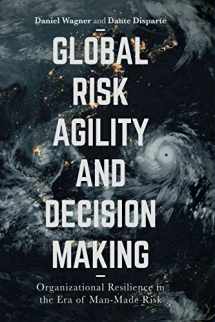
Global Risk Agility and Decision Making: Organizational Resilience in the Era of Man-Made Risk
Book details
Summary
Description
In Global Risk Agility and Decision Making, Daniel Wagner and Dante Disparte, two leading authorities in global risk management, make a compelling case for the need to bring traditional approaches to risk management and decision making into the twenty-first century. Based on their own deep and multi-faceted experience in risk management across numerous firms in dozens of countries, the authors call for a greater sense of urgency from corporate boards, decision makers, line managers, policymakers, and risk practitioners to address and resolve the plethora of challenges facing today's private and public sector organizations.
Set against the era of manmade risk, where transnational terrorism, cyber risk, and climate change are making traditional risk models increasingly obsolete, they argue that remaining passively on the side-lines of the global economy is dangerous, and that understanding and actively engaging the world is central to achieving risk agility. Their definition of risk agility taps into the survival and risk-taking instincts of the entrepreneur while establishing an organizational imperative focused on collective survival.
The agile risk manager is part sociologist, anthropologist, psychologist, and quant. Risk agility implies not treating risk as a cost of doing business, but as a catalyst for growth. Wagner and Disparte bring the concept of risk agility to life through a series of case studies that cut across industries, countries and the public and private sectors. The rich, real-world examples underscore how once mighty organizations can be brought to their knees―and even their demise by simple miscalculations or a failure to just do the right thing. The reader is offered deep insights into specific risk domains that are shaping our world, including terrorism, cyber risk, climate change, and economic resource nationalism, as well as a frame of reference from which to think about risk management and decision making in our increasingly complicated world.
This easily digestible book will shed new light on the often complex discipline of risk management. Readers will learn how risk management is being transformed from a business prevention function to a values-based framework for thriving in increasingly perilous times. From tackling governance structures and the tone at the top to advocating for greater transparency and adherence to value systems, this book will establish a new generation of risk leader, with clarion voices calling for greater risk agility. The rise of agile decision makers coincides with greater resilience and responsiveness in the era of manmade risk.


We would LOVE it if you could help us and other readers by reviewing the book
Book review



